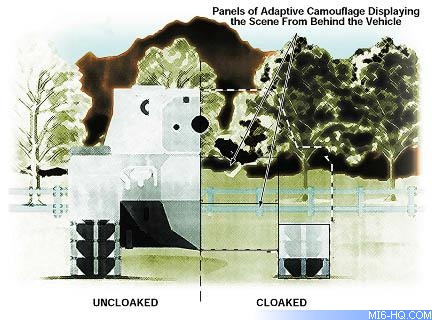 |
| |
The movie world wondered at the magic of 007's "invisible" Aston
Martin Vanquish in "Die Another Day", but the science-fiction technology
was actually grounded on real world research... | |
Adaptive Camouflage - Bond Science
11th
April 2003
Since 1998 (the earliest declassified date available),
the US Army has been investing in developing "adaptive camouflage" technology
for tanks and other ground based units. It earns the "adaptive" moniker
from the camouflage being able to dynamically change its appearance based on the
surroundings it senses.
The simultaneous evolution of digital photography,
projection and displays were the main catalyst behind the overwhelming success
of the project. In under 3 years, a prototype US Army tank fitted out with the
camouflage was reported as invisible to the human eye from 50 yards. Although
the tank was stationary in a controlled environment, and not skidding around a
frozen lake, the results surprised the military researchers.
"At a
distance of 50 yards would make something unrecognizable and in certain conditions
invisible" said Philip I.Moynihan at NASA's Jet Propulsion Laboratory in
Pasadena, California.
Just like Q explained in the film, the prototype used
a series series of small cameras which projected the image they sensed on to a
material suitable for projection of images on the reverse side.
| "On a tank, there were places where you would see
things, like the treads," he said, "So we put skirts on the treads". The
technology is still in its infancy, and is far from the goal of turning a spy's
car invisible to hostile adversaries - "this kind of cloaking would work
best with stationary vehicles, positions, or equipment that troops wish to hide." Right:
The diagram shows how adaptive camouflage can render panels on a tank "invisible"
by displaying the image the sensors see behind it. Image courtesy NASA Jet
Propulsion Laboratory. | | 
|
The special effects used to create the "Aston Martin
Vanish" paper over some of the theoretical cracks. A paper published by NASA
on the subject highlights the issue of shadows. As the vehicle casts a natural
shadow on the ground, to appear invisible from above, the vehicle would have to
illuminate the floor so as not to project its own shadow to observers from above.
As
it stands to day (based on declassified papers), the US Army can use adaptive
camouflage to hide large basic objects. The time when wheels, windows and exhaust
pipes can be hidden are still some time away.
Two paths are currently being
researched by NASA in an attempt to deliver a 100% adaptively camouflaged object.
Special paints and polymers are being developed that can change colour when stimulated
by different levels of electrical current. Of course this technology is unlikely
to deliver the kind of performance Q was using, researchers are confident it is
the most likely way military vehicles will be camouflaged from midrange enemies
in the future.
Further down the theoretical road, and heading into science
fiction territory, is a Department of Defence funded research programme by the
Massachusetts Institute of Technology into nanotechnology. The aim is to create
a legion of microscopic robots that can coat an object and render it totally invisible.
With
digital optics and material science breaking new ground at an ever increasing
pace, scientists in the field predict it will not be too long until adaptive camouflage
is first used in a military environment. How long it will be before we hear about
this, is of course another matter.